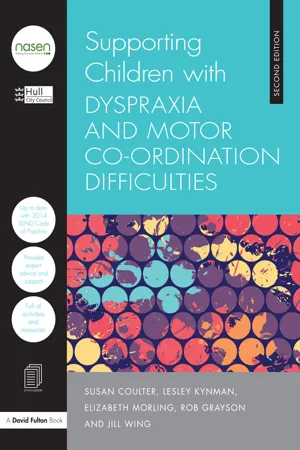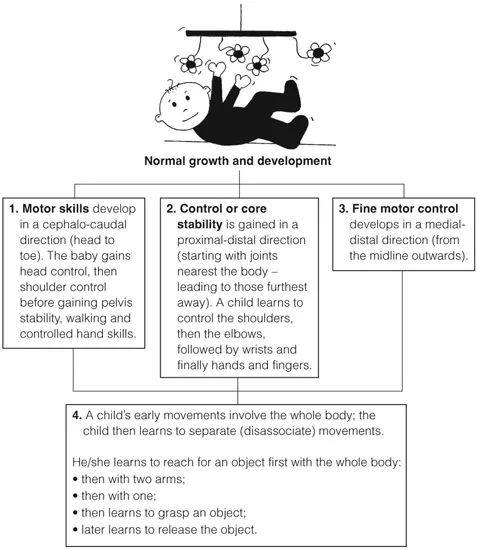![]() Part I
Part I
An overview of co-ordination difficulties![]()
1
Making sense of the senses
A child with motor co-ordination difficulties presents as inattentive and clumsy, sometimes failing to make the academic progress that one suspects he/she is capable of. Parents and teachers can be puzzled as to the reasons for this behaviour. To understand the causes of this type of developmental difficulty one must look at the way in which the senses work together to influence learning.
There are three main senses which need to work effectively together to allow us to experience, interpret and respond to stimuli in our environment. This process is known as sensory integration.
1. Sense of touch (tactile)
The tactile system sends information to the brain, via cells in the skin. This information includes light touch, pain, temperature and pressure. It is this sense which enables us to rummage in a bag to find a pen or a coin without looking.
When the tactile system is not working properly, a child may hate to be cuddled, dislike getting his/her hands dirty and avoid playing with certain textures. He/she may also be sensitive to particular textures in clothing and refuse to eat certain textured foods. The child may be unable to moderate his/her own touch, resulting in rough play, sometimes misinterpreted by others as aggression.
The term ‘tactile defensiveness’ is used to describe a condition where a child is extremely sensitive to the lightest of touches.
When the tactile system is immature, abnormal neural signals are sent to the cortex in the brain, which can interfere with other brain processes. (The cortex is the part of the brain that interprets information.) This interference can lead to the brain being overstimulated, which results in the person having difficulties organising, concentrating and dealing with physical contact with others.
2. Sense of movement (vestibular)
The vestibular system uses structures in the inner ear to detect movement and changes in the position of the head. It enables us to remain upright, to adjust our position, to balance and to interpret movement. The vestibular system helps to maintain muscle tone, co-ordinate the two sides of the body (bilateral co-ordination), and holds the head up against gravity. When the vestibular system is working effectively, a child can look up at the board then return to a book without losing his/her place. He/she can balance on one leg for long enough to kick a ball.
Immaturities in the vestibular system can be seen in two ways: hyper-reaction and hypo-reaction, over- and under-reaction respectively. Some children are hypersensitive to vestibular stimulation and may be frightened of ordinary movements, e.g. using slides, swings, steps and slopes. They may also be apprehensive about walking on uneven or unstable surfaces, e.g. gravel paths or sandy beaches. The child who reacts like this can appear fearful in open spaces, e.g. when in a gym or hall. The other extreme is a child who seeks intense sensory experiences by twirling, jumping and spinning in order to stimulate the vestibular system.
3. Sense of position (proprioceptive)
When a person moves, (proprioceptive) signals are sent from the muscles, tendons and joints to the brain to enable us to know what our body is doing. The proprioceptive system could be described as an internal sense of vision. It enables us to carry out actions without having to look, e.g. fastening the top button of a shirt or putting on a jumper over the head.
When the proprioceptive system is not working correctly, a child may appear clumsy, fall often, have limited understanding of his/her position in space, and bump into furniture or brush along the wall when walking in a corridor. The child may have difficulty handling small objects, leading to problems with independence skills and fine motor skills.
Another aspect of proprioception is ‘praxis’ or motor planning. This is the ability to plan and execute motor tasks. This is essential to learning new skills.
In summary, sensory integration takes place in the following way:
- Input – information from the sensory system goes into the brain via sensory pathways.
- Processing – the information from the senses is processed and sent to other centres within the brain where it is ‘made sense of’ and translated into perception and learning. This is a two-way journey, with information being sent back to the sensory systems to enable modification of movement and behaviour.
- Output – the brain then enables the child to carry out integrated actions, e.g. movements, interaction and functions.
When there is a problem in processing information from one of the sensory systems, the result can be poor functioning in a number of areas, as the sensory pathways are all interconnected.
References
Wright, Sally (June 1989) Physiotherapy: Applied to the Treatment of the Child with Dyspraxia, Dyspraxia Trust.
![]()
2
Understanding physical development
Once an understanding of how the sensory systems work together to allow the child to interact with his/her environment has been established, the stages of normal physical development need to be considered. An understanding of these stages may help teachers prioritise areas of skill development. Age-referenced stages of normal development in the areas of gross motor, fine motor and independence skills precede the relevant sections.
Reference
Klein, M.D. (1982) Pre-writing Skills: Skill Starters for Motor Development, Communication Skill Builders.
![]()
3
Identifying children with co-ordination difficulties
The table below is intended to help teachers build up a profile of the child who is experiencing motor co-ordination difficulties. Possible difficulties have been categorised into the stage in which they are typically seen. It should be noted that children in key stages 1 and 2 are likely to experience some of the difficulties listed in the Foundation Stage section. Similarly, some pupils in key stages 3 and 4 will experience difficulties from earlier key stages. Corresponding sections of the book provide classroom strategies which can be used to target specific areas of development. Appendix 2 provides pro-formas for a pupil profile.
| Area of development | Possible difficulties seen at the Foundation Stage |
|
| Sensory | - very excitable, making shrill or loud noises, hand flapping
- cannot sit still during circle or story time
- limited concentration, flitting from one activity to another
- distressed by high levels of noise
- dislikes being touched or avoids certain textures
- fiddles, chews objects or clothes
- poor safety awareness or a fear of heights
- fussy eater.
|
|
| Gross motor skills | - clumsy movements, bumps into objects, falls, trips
- easily knocked off-balance
- difficulty climbing on a small climbing frame
- difficulty getting into or onto play equipment and chairs
- jumps from inappropriate heights with no sense of danger
- has to squat to pick up toys from the floor
- difficulty getting up from the floor without using hands
- difficulty jumping with both feet together
- difficulty pedalling a tricycle
- climbs the stairs leading with one foot
- difficulty throwing, catching and kicking a large ball.
|
|
| Fine motor skills | - uncertain of hand dominance
- avoids jigsaws and construction toys
- poor pencil grip
- unable to use scissors
- struggles to build tower of six one-inch cubes.
|
|
| Independence skills | - difficulty taking off coat and hanging it on a peg
- struggles with undressing
- unable to use the toilet independently
- messy eater, prefers to finger-feed
- spills drinks.
|
|
| Communication | - plays alone, rather than in a group
- lack of imaginative play
- difficulty following simple routines and instructions
- unclear speech, cannot speak in sentences
- avoidance of eye contact.
|
|
| Area of development | Possible difficulties seen at Key Stages 1 and 2 |
|
| Sensory | - easily distracted, lacks persistence
- unable to use space effectively in PE or playground
- difficulty judging distance and direction
- difficulty sitting still
- dislikes being touched
- can be rough in play without realising
- irrational fear of open space or heights
- poor self-image, attention-seeking behaviour, withdrawn, underactive, reluctant to participate
- lacks inhibition
- poor ...
|


